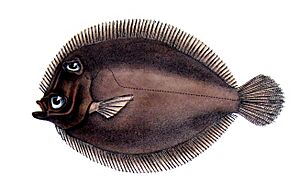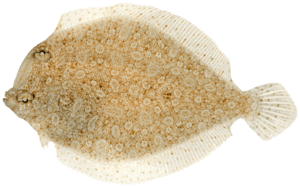Eyed flounder facts for kids
Quick facts for kids Eyed flounder |
|
|---|---|
 |
|
| Conservation status | |
| Scientific classification | |
| Synonyms | |
|
The eyed flounder (Bothus ocellatus) is a type of flat fish. It belongs to a family called Bothidae, also known as lefteye flounders. You can find this fish living on or near sandy parts of the ocean floor. It prefers shallow waters in the western Atlantic Ocean, the Caribbean Sea, and the Gulf of Mexico.
Contents
What Does the Eyed Flounder Look Like?
The eyed flounder has a flat, round body. It can grow up to 18 cm (7 in) long, but most are around 12 cm (5 in). Like other lefteye flounders, it lies on its right side. As it grows, its right eye moves to the left side of its head.
Its mouth is large and can stick out. Male flounders have a small spine on their nose. They also have a bony bump in front of their lower eye. Both eyes are big and stick out a bit. The lower eye is slightly closer to the nose than the upper one. There's a fleshy ridge above and behind each eye.
The top fin, called the dorsal fin, has 76 to 91 soft rays. It starts near the upper eye and is long and ribbon-like. There's a space between this fin and the tail fin. The bottom fin, called the anal fin, has 58 to 69 soft rays. It is also long and separate from the tail fin.
Color and Markings
This fish is usually pale tan, grey, or brown. It has patches, spots, and ring-shaped patterns. The eyed flounder is amazing because it can change its color quickly. It can match its body color to its surroundings in just two to eight seconds!
It has three larger dark spots on its straight lateral line. The lateral line is a special sense organ that helps fish detect movement in the water. There are also two fainter spots on its tail. You can tell it apart from the twospot flounder (Bothus robinsi) by these tail spots. In the eyed flounder, the tail spots are one above the other. In the twospot flounder, they are one behind the other. The underside of the eyed flounder is pale.
Where Do Eyed Flounders Live?
The eyed flounder lives in the western Atlantic Ocean, the Caribbean Sea, and the Gulf of Mexico. Its range stretches from Canada all the way to southern Brazil.
Eyed Flounder Habitat
This fish usually lives on sandy flat areas. These spots are often near small coral reefs, areas with broken coral, or seagrass meadows. It commonly lives at depths of about 50 m (164 ft). Sometimes, it can be found deeper, down to 110 m (361 ft). The eyed flounder spends most of its time lying on the seabed. It sometimes even buries itself partly in the sand.
Eyed Flounder Biology
What Do Eyed Flounders Eat?
The eyed flounder eats other fish, which makes up about a third of its diet. It also enjoys eating crustaceans. These include crabs, mantis shrimps, shrimps, and small creatures called amphipods.
Reproduction and Life Cycle
Near the island of Bonaire, eyed flounders reproduce during the winter. A male eyed flounder will claim and protect an area, called a territory. In this territory, there can be up to six females, each with her own smaller space.
Courtship begins about an hour before sunset. As the sun sets, the female swims a short distance above the ocean floor. The male swims right below her. At the same time, both release their eggs and sperm into the water. This is called spawning. The male tries to mate with each female every day.
When the fertilized eggs hatch, tiny baby flounders, called larvae, emerge. They are pelagic, meaning they float freely in the open water. They are part of the plankton, which are tiny organisms that drift in the ocean. At first, their eyes are on opposite sides of their head, like most fish. But as they grow, their right eye moves to the left side of their head.
Young flounders and larvae are eaten by many other fish and invertebrates. Adult eyed flounders are hunted by bigger fish, gulls, egrets, herons, seals, and sea lions.



